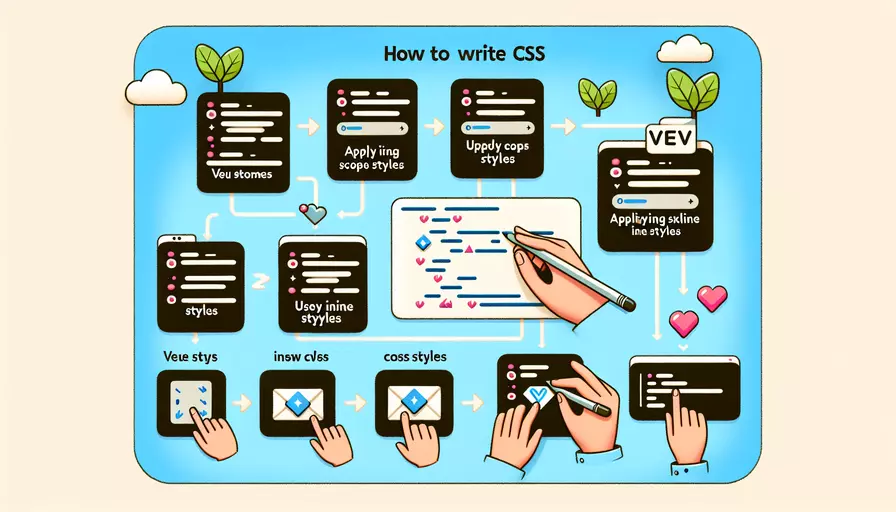
在Vue中编写CSS有多种方式,具体有以下几种主要方法:1、在组件的style标签中直接编写;2、使用scoped样式;3、使用CSS Modules;4、使用外部的CSS文件;5、使用预处理器如Sass或Less。这些方法各有优缺点,适用于不同的场景。
一、在组件的style标签中直接编写
在Vue单文件组件(.vue文件)中,可以在style标签中直接编写CSS样式。这是最基本的方法,适用于简单的样式需求。
<template>
<div class="example">Hello Vue!</div>
</template>
<script>
export default {
name: 'ExampleComponent'
}
</script>
<style>
.example {
color: blue;
}
</style>
这种方式的优点是简单直观,缺点是样式容易全局生效,不适合复杂项目。
二、使用scoped样式
为了避免样式污染,可以使用scoped属性,使样式仅作用于当前组件。
<template>
<div class="example">Hello Vue!</div>
</template>
<script>
export default {
name: 'ExampleComponent'
}
</script>
<style scoped>
.example {
color: blue;
}
</style>
scoped样式会生成独特的数据属性,确保样式只作用于当前组件,缺点是可能会带来性能开销。
三、使用CSS Modules
CSS Modules是一种模块化的CSS方案,可以将CSS样式封装成模块,避免样式冲突。
<template>
<div :class="$style.example">Hello Vue!</div>
</template>
<script>
export default {
name: 'ExampleComponent'
}
</script>
<style module>
.example {
color: blue;
}
</style>
使用CSS Modules需要在Vue配置文件中进行相应的配置,适合大型项目。
四、使用外部的CSS文件
可以将CSS样式写在外部CSS文件中,然后在Vue组件中引入。这种方式适合样式复用和团队协作。
<template>
<div class="example">Hello Vue!</div>
</template>
<script>
import './example.css';
export default {
name: 'ExampleComponent'
}
</script>
这种方法的优点是样式文件独立,易于管理,缺点是样式作用域难以控制。
五、使用预处理器如Sass或Less
Vue支持使用Sass、Less等预处理器来编写CSS,这可以带来更强大的功能和更简洁的代码。
<template>
<div class="example">Hello Vue!</div>
</template>
<script>
export default {
name: 'ExampleComponent'
}
</script>
<style lang="scss">
.example {
color: blue;
}
</style>
使用预处理器需要安装相应的loader,并在Vue配置文件中进行配置,适合复杂样式需求的项目。
总结
在Vue中编写CSS有多种方式,包括直接在style标签中编写、使用scoped样式、CSS Modules、外部CSS文件和预处理器等。每种方式有其优缺点,选择时应根据项目规模、团队协作和样式复杂度等因素进行综合考虑。建议在小型项目中使用scoped样式或直接在组件中编写CSS,而在大型项目中则可以考虑CSS Modules或预处理器,以提高代码的可维护性和可复用性。
相关问答FAQs:
1. 在Vue中如何使用内联样式?
在Vue中,你可以通过使用style属性来应用内联样式。你可以直接在模板中使用该属性,并将样式规则作为一个对象传递给它。例如:
<template>
<div>
<p :style="{ color: 'red', fontSize: '16px' }">这是一个红色的段落</p>
</div>
</template>
在这个例子中,我们将color属性设置为red,将fontSize属性设置为16px。你还可以使用Vue的数据绑定功能来动态地改变样式。例如:
<template>
<div>
<p :style="{ color: textColor, fontSize: textSize + 'px' }">这是一个动态样式的段落</p>
</div>
</template>
<script>
export default {
data() {
return {
textColor: 'blue',
textSize: 20
}
}
}
</script>
在这个例子中,我们使用了一个data属性textColor和textSize来存储样式的值。通过改变这些值,你可以动态地改变段落的颜色和字体大小。
2. 如何在Vue中使用CSS类?
在Vue中,你可以使用class属性来应用CSS类。你可以直接在模板中使用该属性,并将类名作为一个字符串传递给它。例如:
<template>
<div>
<p class="red-text">这是一个红色的段落</p>
</div>
</template>
<style>
.red-text {
color: red;
}
</style>
在这个例子中,我们将class属性设置为red-text,并在<style>标签中定义了一个相应的CSS类。这样,段落的文字颜色就会变成红色。
你还可以使用Vue的数据绑定功能来动态地改变CSS类。例如:
<template>
<div>
<p :class="{ 'red-text': isRed }">这是一个动态样式的段落</p>
</div>
</template>
<script>
export default {
data() {
return {
isRed: true
}
}
}
</script>
在这个例子中,我们使用了一个data属性isRed来存储一个布尔值。通过改变这个值,你可以动态地添加或移除CSS类,从而改变段落的样式。
3. 如何在Vue中使用CSS模块化?
在Vue中,你可以使用CSS模块化来隔离组件的样式。首先,你需要在组件的<style>标签中添加module属性。例如:
<template>
<div>
<p class="red-text">这是一个红色的段落</p>
</div>
</template>
<style module>
.red-text {
color: red;
}
</style>
在这个例子中,我们在<style>标签中添加了module属性,这意味着该样式只适用于当前组件。然后,我们定义了一个CSS类.red-text,并将其应用到段落中。
为了在模板中使用CSS模块化的样式,你需要使用$style对象。例如:
<template>
<div>
<p :class="$style.redText">这是一个红色的段落</p>
</div>
</template>
<style module>
.redText {
color: red;
}
</style>
在这个例子中,我们使用了$style对象来引用CSS类.redText。这样,段落的文字颜色就会变成红色。
使用CSS模块化的好处是,它可以避免全局样式的冲突,并使组件的样式更加可维护和可重用。
文章标题:vue中css如何写,发布者:worktile,转载请注明出处:https://worktile.com/kb/p/3661233

 微信扫一扫
微信扫一扫  支付宝扫一扫
支付宝扫一扫 